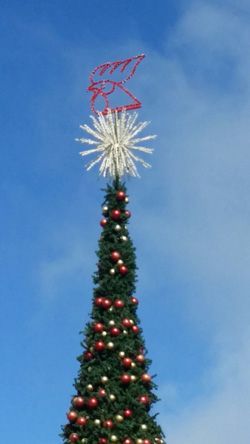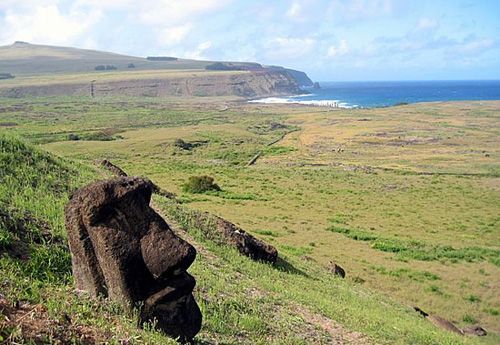ARCAS: US AND THEM
| January 3, 2016
We traveled to the ARCAS Wildlife Rescue Center near here by boat—two boats actually: we took one across the lake to a deserted patch of shoreline where a hidden dock revealed itself and then, after a brief hike through the jungle where some explanatory signs had been placed, we boarded a rowboat and crossed a pond to the main, more remote part of ARCAS. That area must remain remote in order to facilitate the successful return of the rescued animals they deal with to the wild, as minimal contact with humans is necessary; if the animals under their care get too used to being around humans they will be at risk. It's a tricky balance, as some of the animals need quite a bit of care before they become self-sufficient.
What do they do here at ARCAS? The animal activists’ aims are twofold: to release captured animals back into the wild, if possible, and to increase the population of local animals that are near extinction (mainly as a consequence of human behavior).
Where do these captured animals come from? It seems quite a lot of parrots, macaws, monkeys and other local wildlife are often captured and then secretly and brutally exported—they're worth a lot on the black market. Some of the animals are purchased by local drug lords and wealthy Guatemalans, who have gotten into the habit of having private zoos. One cache was discovered by the animal manager of a high-end hotel and, as a friend of ARCAS and aware of the issues of animal conservation, he told the smuggler, “You know who I am and where I stand. This is illegal so give up the animals or I will rat you out.” I suspect he didn’t say it in exactly those words, but that’s what we were told.
Real animal rehabilitation is not like it’s often portrayed in the movie scenes where the cute baby bird with the injured wing is fed by hand and the bird eventually gets healthy and happily flies away. Rather, the ARCAS folks discovered—after failing quite a few times in their 25-plus years here—that an animal rehabilitated by humans in such a sentimental way has almost no chance of surviving in the wild. Humans can't teach the aspects of species behavior that an animal's family or group can. Animals have culture, just like we do, and it is passed on to younger generations by family and the social group, just as it is with humans. Like us, they might be innately primed to receive and integrate those behaviors once exposed to them, but they do need to be exposed to them at the right time in their lives.
For example, spider monkeys (which we saw fairly often in the wild) need to learn their species’ fairly rigorous and complicated social hierarchies in order to know how to navigate life as part of a group of other monkeys. Humans can't teach them that. A lone animal—one that is innately social but has been separated from its clan and didn’t learn how to navigate life in a group—is doomed. (However, some solitary not-so-social animals, including jaguars, can be released if they haven't bonded with humans.)
In attempting to observe how these social hierarchies work, the staff have noticed that behavior in the wild, or in very large enclosures—think Jurassic park—is quite different than behavior observed in zoo-like confinements. This might seem obvious, but behavioral myths borne from observing confined animals continue to be propagated. For example, I was told that the idea of the alpha wolf is simply not true; wolf pack behavior is much more malleable and nuanced than is popularly understood. Yet the legend of the alpha wolf—an idea derived from observing animals in captivity—is now hard to dislodge.
The animals here at ARCAS are separated into two groups: those they hope to reintroduce into the wild and those they cannot. Parrots who have learned to speak human words (often swear words or people's names) cannot be let go as the flock would view them as vocal freaks and consequently ostracize them. Think if they did fit in—one can only imagine curse words and human names randomly emanating from somewhere overhead in the jungle. The same effect of human contact goes for the wild boar, although surely no one has captured a boar to have as a pet—and certainly they don’t learn to imitate human utterances! Boars are social animals and to release one from captivity without it having the knowledge of its wild ways and pack behavior would not give it good odds of surviving. In the words of the ARCAS team, it would be like “dropping a frat boy into a ghetto gang.” That sounds like a premise for a Hollywood movie if you ask me.
Macaws are another one of the species that has to be separated in this way. Psychologically damaged birds pluck out their own feathers (a bit like cutting I guess) and, if the behavior persists, eventually the feathers don't grow back. Sad. But some of the macaws here are doing well—breeding, forming groups and families—and are moved to increasingly larger enclosures where they learn to fend for themselves and they will eventually be released into the wild if all goes well.
The last step before release entails putting the animals into a distant enclosure in the jungle surrounded by an electrical fence, like in Jurassic Park. It is open to the sky and large enough to sustain social life and food gathering—it’s so large, in fact, that I can't see the end of it. If the animals manage to do OK in this area, they are deemed ready for release.
There is an estimated only 300 wild Scarlet Macaws in the Mayan Jungle and, as such, they are in grave danger of extinction. The blue macaw, which a friend's father remembers seeing in flocks on the riverbanks of the western lowlands, has been wiped out in our lifetime. On the bright side, Dr. Alejandro Morales, veterinarian and Assistant Director at ARCAS, told us that they “plan to reinforce the population with at least 10% more animals, having already done the first ever release of Scarlet Macaws bred in captivity, and are currently tracking their development. This first release equals 3% (or maybe more) of the remaining population in the area.”
It’s one thing to reintroduce these captured animals and those on the verge of extinction—of course parrots, monkeys, jaguars, and peccaries (what might be considered a Central and South American boar)—have a place in the ecology and their absence would throw things out of balance in ways we can’t imagine, but our impact on this balance is often more profound than we might think.
Andres, a friend of the owner of the Ni’tun reserve and retreat here in San Andreas, owns a coffee plantation in the lowlands on the western side of Guatemala where he also raises tilapia and sheep. He mentioned that the tilapia raised at higher altitudes grow slower and are tastier, but so far he can't price them accordingly—to most people tilapia are all the same. Anyway, a river flows through his property and it used to teem with fish and shrimp but now they're all gone. That river is named after a kind of shrimp that can no longer be found there, as fishermen used to poison the river upstream in order to collect the dying critters downstream. After years of this abuse the river exhausted its ability to recuperate. Andres didn’t have a clue when I asked him how the wildlife might be reintroduced, as it’s a matter of restoring a whole ecosystem and not just tossing some fish and shrimp back in the river. The reintroduction process is not simple...neither is managing a common resource like that river.
Nobel Prize winner Elinor Ostrom wondered how contained areas might manage their common resources without what she calls a "sword": a punishing, top-down management system that would regulate, for example, how much shrimp are removed each year. She wondered if self-regulation, a “covenant without a sword” as she called it, might be possible and, if so, how to institute a system by which a community might self-manage their resources so that it would be sustainable and exist for future generations to derive their livelihoods from.
It turns out there's no simple answer, but sometimes it does seem to work. It is possible to avoid “the tragedy of the commons” in communities and economies that are more or less self-contained—where the community and the resources are constant and a symbiotic relationship can develop. Outsiders who intrude on such a system—by either offering huge bounties and consequently upping the demand for the resource (lumber, sheep, fish, shrimp, etc.) or simply scooping up the resources for themselves (as Japanese and Chinese trawlers have done in Southeast Asia and the Mediterranean, for example)—make such a tenuous balance all but impossible to achieve.
There are far fewer contained, isolated ecologies now—we live in a global economy, but humans are not built to feel that sense of emotional belonging at a global scale...sadly, it goes against our nature. That is, unless we can widen our sense of “community” to include the whole world—unless we realize that our communities are not isolated and actions like illegal trawling will eventually generate a blowback, maybe not right away, but one that will almost certainly affect our children. This global view is pretty hard to assume, as we’ve evolved to favor local groups over those that are further afield, but if we can have some foresight then we might stand a chance. If we could truly adopt that viewpoint then, in theory, we wouldn’t even need an enforcement structure. The UN is currently supposed to act as an enforcer, but with all the squabbling and lack of teeth, it hasn’t worked that well.
What to do? The Environmental Defense Fund is seeking ways to combat our tendency to deplete our common resources. Their website mentions a program called “catch shares” that functions as a way to deal with this resource management problem.
They say it’s working relatively well in Scandinavia and the Pacific Northwest, as each of these communities has a shared and consistent governing body that provides clear, mutually agreed upon rules that are consistently and transparently enforced. However, the same system did not work in the Mediterranean, as the region has shared shorelines—i.e., areas used by multiple nations—so while one group might self-regulate their neighbor might poach. Indonesia seemed like a promising place to try out their idea, but Chinese and Vietnamese trawlers intruded, often necessitating the intervention of Indonesian warships to defend the fishing grounds. Additionally, although it has been outlawed, dynamite fishing by locals continues to destroy coral reefs in Southeast Asia—a tragedy playing out rapidly. Needless to say, these bad actors make instituting common resource management very, very difficult.
But the system is working in some places around the world, so there is guarded reason for optimism that we won’t totally and inevitably foul our nest as we have done historically. Management is a hard idea to accept. Domestically, Republicans, anti-regulation as they are, have consistently voted down measures like these and consequently our fish supplies, as just one example, continue to dwindle.
Of course extinction is a natural process—it's part of evolutionary change, not all of which should be mourned. New species, better adapted, replace others. However, much change is now driven by just one species—us humans and the climate change that we have caused—and the pace of this change is increasing, so there is cause for concern. Though one could argue that, being part of nature ourselves and existing in the anthropogenic era—the human influenced era, with its human-driven extinctions, extreme weather, and rising seas—all of these changes are part and parcel of that epoch and this mess is therefore, by definition, also a natural process. To foul one’s nest and risk self-extinction, or at least radical and widespread pain and misery, can be viewed as a natural process. But reducing that pain and misery is then a natural process, too. Which would you rather?
So, human behavior and its consequences are indeed part of a natural process—like swarming locusts or plagues—but as self-aware beings we can see what is happening and take steps to alter our behavior. It is doubtful that animals have that ability....does that ability then imply some responsibility? The tragedy of the commons repeats itself. Like animals, we have overgrazed and exhausted resources essential to our survival over and over again. Reading the chapters discussing the collapse of Mayan and Easter Island cultures in Jared Diamond's book Collapse: How Societies Choose to Fail or Succeed, one imagines the hapless soul looking at the last tree on Easter Island as he is about to cut it down.
We do this. We are not really much wiser than that man yet we persist in believing that we are different and that we have the ability to foresee consequences...and, sometimes, we do manage to act collectively in order to save ourselves. We do have an innate drive to behave morally and reasonably within our social group—just like the monkeys and macaws. There is regulation within small groups that halts runaway greed and selfishness.
Maybe it’s not hopeless—but we do have many competing and conflicting impulses to combat. That in-built small-group balance doesn’t automatically extend to the wider world. The impulse to see ourselves as separate from nature, from the wider world, is maybe natural in itself, but it is in fact an illusion. Likewise, the impulse to be nature's custodian—to see ourselves as managers who understand all the repercussions of our actions—might also be innate but is similarly a presumption based on that same illusion.
As visitors leave ARCAS, they are placed inside a cage as a kind of experiment in empathy. The scale of the cage is relative to the space within which a captive animal—a pet bird or monkey, for example—would spend its entire life. Needless to say, the cage feels tiny, and the fact that this brief experiment allows one to imagine being cooped up in a space that size perhaps does more to argue for their work than words ever could.
DB
Guatemala










